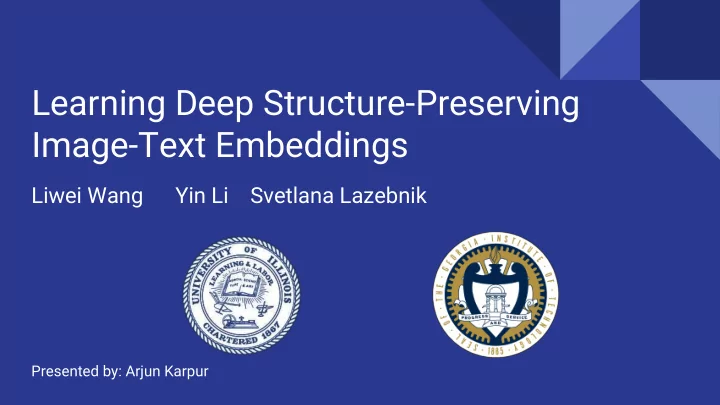

Learning Deep Structure-Preserving Image-Text Embeddings Liwei Wang Yin Li Svetlana Lazebnik Presented by: Arjun Karpur
Outline ● Problem Statement Approach ● Evaluation ● ● Conclusion Image courtesy of: http://calvinandhobbes.wikia.com/
Problem Statement
Problem Statement ● Given collection of images, sentences Perform retrieval tasks... ● ○ Image-to-text ○ Text-to-image “The quick brown fox jumped over the lazy dog” Image courtesy of: http://nebraskaris.com/
Problem Statement ● Given collection of images, sentences Perform retrieval tasks... ● ○ Image-to-text ○ Text-to-image Useful for… ● ○ Image captioning Visual question answering ○ ○ etc... “The quick brown fox jumped over the lazy dog” Image courtesy of: http://nebraskaris.com/
Problem Statement ● Given collection of images, sentences Perform retrieval tasks... ● ○ Image-to-text ○ Text-to-image Useful for… ● ○ Image captioning Visual question answering ○ ○ etc... “The quick brown fox jumped Utilize ‘ joint embedding’ to compare ● over the lazy dog” differing modalities Image courtesy of: http://nebraskaris.com/
Joint Embedding The dog plays in the park. The student reads in the library Embedding space Images courtesy of: https://www.wikipedia.org
Joint Embedding The dog plays in the park. The student reads in the library Embedding space Images courtesy of: https://www.wikipedia.org
Joint Embedding The dog plays in the park. The student reads in the library Embedding space Images courtesy of: https://www.wikipedia.org
Approach
Approach ● Multi-view shallow network to project existing representations into embedding space Any existing handcrafted or learned ○ ○ One branch for each data mode Image courtesy of: Wang et. al 2016
Approach ● Multi-view shallow network to project existing representations into embedding space Any existing handcrafted or learned ○ ○ One branch for each data mode Nonlinearities allow modeling of more ● complex functions Image courtesy of: Wang et. al 2016
Approach ● Multi-view shallow network to project existing representations into embedding space Any existing handcrafted or learned ○ ○ One branch for each data mode Nonlinearities allow modeling of more ● complex functions ● Improve accuracy via L2 normalization before embedding loss Image courtesy of: Wang et. al 2016
Training Objective ● Loss function comprising of… a. Bi-directional ranking constraints - encourage short distances between an image/sentence and its positive matches and large distances between image/sentence and negatives ■ Cross-view matching
Training Objective ● Loss function comprising of… a. Bi-directional ranking constraints - encourage short distances between an image/sentence and its positive matches and large distances between image/sentence and negatives ■ Cross-view matching b. Structure-preserving constraints - images (and sentences) with identical semantic meanings are separated from others by some margin ■ Within-view matching
Bi-directional Ranking Constraints ● Given a training image , let and represent its matching and non-matching sentences
Bi-directional Ranking Constraints ● Given a training image , let and represent its matching and non-matching sentences Want distance between and to be less than distance between ● and by some margin ...
Bi-directional Ranking Constraints ● Given a training image , let and represent its matching and non-matching sentences Want distance between and to be less than distance between ● and by some margin ... Image courtesy of: FaceNet [Schroff et. al]
Structure-preserving Constraints ● Neighborhood of images (or sentences - same modality) with shared meaning Image courtesy of: Wang et al 2016
Structure-preserving Constraints ● Neighborhood of images (or sentences - same modality) with shared meaning ● Enforce margin between and points outside Image courtesy of: Wang et al 2016
Structure-preserving Constraints ● Neighborhood of images (or sentences - same modality) with shared meaning ● Enforce margin between and points outside Remove ambiguity for a query ● image/sentence Image courtesy of: Wang et al 2016
Loss Function } Cross-view } Within-view Use ‘triplet sampling’ to efficiently train, given nearly infinite triplets
Evaluation
Evaluation ● Evaluate image-to-sentence and sentence-to-image retrieval Datasets ● ○ Flickr30K - 31783 images, each described by 5 sentences ○ MSCOCO - 123000 images, each described by 5 sentences Perform Recall@K (K = 1,5,10) for 1000 test images and corresponding ● sentences
Datasets - Flickr30k Image courtesy of: http://web.engr.illinois.edu/~bplumme2/Flickr30kEntities/
Quantitative Results - Recap Using joint-loss, fine-tuning method on top of handcrafted feature ● outperforms deep methods All components of loss function contribute to good results ●
Compared to baselines, achieve high results even without focusing on object detection Image courtesy of: Wang et al 2016
Conclusion
Strengths & Weaknesses + - ● Works with any pre-existing ● Hard to find a single sentence that embedding (finetune or train from describes multiple images (or vice scratch) versa) ● Robust 2-way embedding method ● Only allows for retrieval, not synthesis (image captioning) ● L2 normalization allows for easy Euclidean distance comparisons ● Requires large collection of labeled pairs
Extensions ● Use framework for other data pairs in different modalities (audio + video) ● Leverage data pairs that arise naturally in the world for unsupervised learning
References ● Wang, Liwei, Yin Li, and Svetlana Lazebnik. "Learning deep structure-preserving image-text embeddings." Proceedings of the IEEE Conference on Computer Vision and Pattern Recognition. 2016. APA ● Schroff, Florian, Dmitry Kalenichenko, and James Philbin. "Facenet: A unified embedding for face recognition and clustering." Proceedings of the IEEE Conference on Computer Vision and Pattern Recognition. 2015. Various image sources... ●
Comments + Questions
Recommend
More recommend